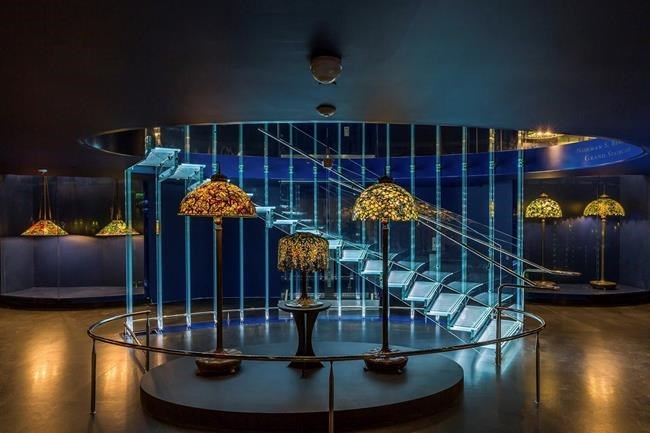
This undated photo provided by the New York Historical Society Museum and Library shows an installation view of The Gallery of Tiffany Lamps, designed by renowned Czech architect Eva JiÅ™iÄná, and comprises a 4,800-square-foot, two-story space measuring nearly a city block with its soaring glass Norman S. Benzaquen Grand Staircase. (Corrado Serra/New York Historical Society Museum and Library via AP)
May 30, 2017 - 7:02 AM
NEW YORK - A newly renovated section of the New-York Historical Society showcases dozens of lamps by Louis Comfort Tiffany, putting renewed focus on how the works were made — and by whom.
The 4,800-square-foot Gallery of Tiffany Lamps, a permanent display area on the museum's fourth floor, features a dramatic glass staircase leading to a mezzanine where there are high-tech, interactive displays, as well as actual templates and tools used to make Tiffany lamps.
The new floor also features a Center for Women's History and a section on interpreting U.S. history through the lens of New York. But the real eye-catchers are the 100 lamps, made starting in 1898 for use with kerosene and later electricity, and all illuminated here for maximum impact.
"Electricity was very liberating from a design standpoint because it permitted much more slender lamp bases, as opposed to the bulbous bases required for use with kerosene," explains museum director Margaret K. Hofer, who curated the exhibit with Rebecca Klassen.
The show reveals the subtle gradations of colours and textured glass, and the enormous range of bases, for which Louis C. Tiffany and his firm were famous.
But the thrust of the exhibit is to dispel the long-held idea that Tiffany himself crafted the now-iconic lamps. It celebrates the crucial and little-known role of women in their design and production.
The focus is on Clara Driscoll, an aspiring artist from Ohio, and her team of "Tiffany girls" in the Women's Glass Cutting Department. Their importance was revealed only in 2005 with the discovery of Driscoll's correspondence, some of which is on view at the museum.
"Many people don't realize that while Tiffany had the artistic vision, approved all the designs and led the firm, he employed skilled designers and craftspeople — many of them women — who did the actual designing, glass cutting and crafting," says Hofer.
"The many letters Driscoll wrote home while working for Tiffany were languishing in archives in Ohio and in Queens, and they reveal that she was responsible for the designs of most of the nature-themed lamps. They also reveal a trove of new information about the workings of Tiffany Studios," she says.
Highlights include examples of Tiffany's famous Dragonfly shade, including variations of the original design conceived by Driscoll in 1899 featuring dragonflies with brass filigree wings and gleaming glass eyes.
Also featured are a rare Gourd shade on a root base (one of only two known to exist); a unique Clematis hanging shade; a Fruit shade depicting ripening fruits around the circumference of a shade set above a sinuous bronze and pottery base; and an elaborate Cobweb shade on a Narcissus mosaic base, all from around 1900.
Driscoll was also behind the famous Wisteria and Poppy shades, in addition to other works in glass and bronze. Along with her design work, she managed a large department in which women selected and cut glass for lamp shades, windows and mosaics.
The company employed both men and women, but the genders were tasked with designing different types of lamps. For the most part, women selected and cut glass for designs featuring flora and insects. Men were assigned lamps in geometric patterns, often meant for studies, offices and libraries.
There was often friction between the departments, according to Driscoll's correspondence. In one case, Clara made colour charts for the men for a certain design, and she writes about how nervous she was to criticize them.
Adding depth to the exhibit, a large, interactive diorama illustrates the rise of electrification in the area around 25th Street, where Tiffany Studios was based. There's also a model of the boarding room in which Driscoll sat while writing much of her correspondence.
"She wrote her letters home by the light of a kerosene lamp, but her window looked out onto a city being transformed by electricity," Hofer says.
Driscoll worked at Tiffany Studios for most of 20 years. Because only single women were permitted to work at the firm, she was forced to leave upon her marriage in 1889, returning after her husband died several years later. Her career ended when she married again in 1909.
Louis Tiffany, a pioneer of Art Nouveau style, was a painter and interior designer, as well as a glassmaker. Born in New York City in 1848, he was the son of Charles Tiffany, founder of the Tiffany and Co. store, which now stands on Fifth Avenue.
Louis Tiffany created a type of glass he called "Favrile," which stood out in its vibrant and iridescent coloring, and eventually started his own firm.
Tiffany retired in 1919. Tiffany Studios filed for bankruptcy in 1932, and he died in 1933. The company's records were destroyed, causing most documentation of its workings to be lost — until the recent discovery of Driscoll's meticulous notes.
News from © The Associated Press, 2017